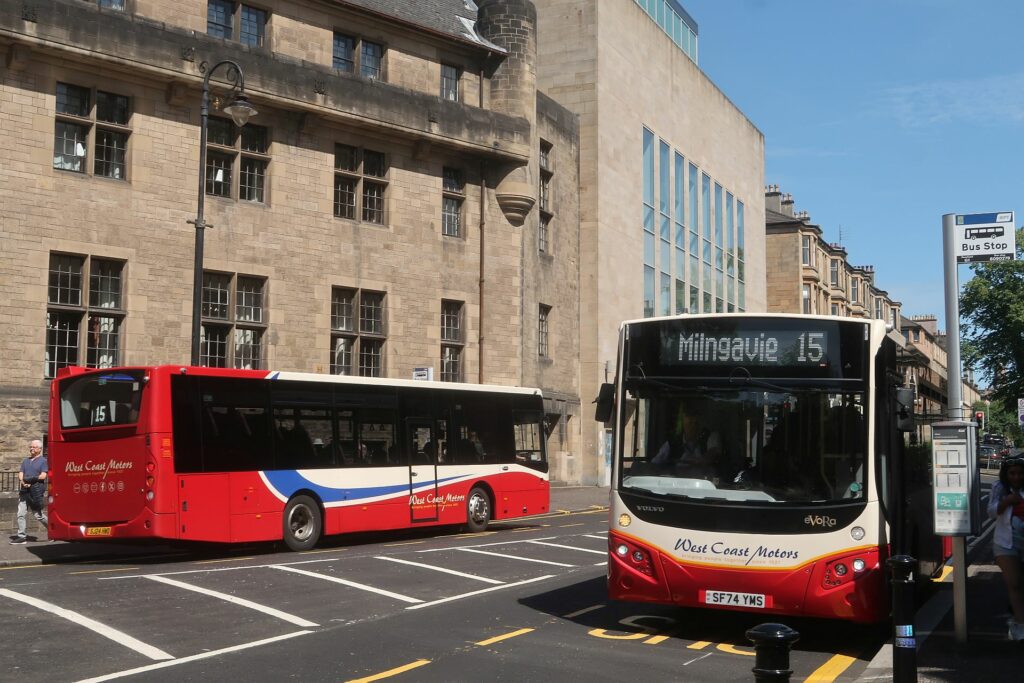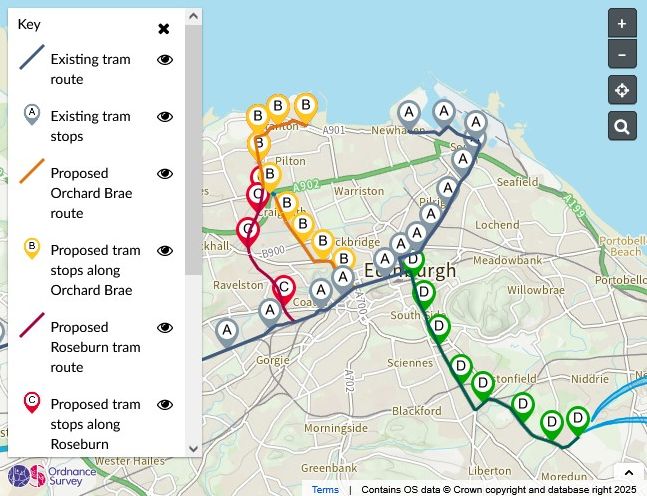This website item outlines a positive development in public transport that provides real benefits for those living or working in one large area of Greater Glasgow. It involves a route that passes close to my home in Bearsden and is therefore of particular interest to me. This is the No. 15 bus route between Milngavie Station and the centre of Glasgow at Cathedral Bridge above Queen Street Station. Services are provided by West Coast Motors (WCM) using modern vehicles with low-emission engines, low-access floors and a wheelchair bay. The buses can accommodate up to 78 passengers. WCM has provided services on this route for several years (partially on behalf of the Strathclyde Partnership for Transport (SPT)), but recent changes have greatly enhanced what is available.
It is essential to note that this bus service does not offer the fastest way to travel from the centre of Glasgow to Milngavie, but it does provide important links between places that are otherwise poorly served by public transport. From the centre of the city, the route follows Bath Street to Charing Cross, then along Woodlands Road to the Gilmorehill campus of the University of Glasgow. From there, it crosses Byres Road and continues through Hyndland to Great Western Road and Anniesland Cross. After Anniesland, buses proceed along Bearsden Road and Switchback Road (serving the Garscube campus of the University of Glasgow) to Canniesburn Toll and on along Drymen Road through Bearsden Cross and by Duntocher Road to the junction with Ledi Drive. From there, the route winds its way through housing estates at Bonnaughton and Baljaffray, both of which are within Bearsden. It then follows Stockiemuir Road and enters the Mains Estate in Milngavie. Making its tortuous way through various housing areas to the north and west of the town centre, the route eventually passes the busy pedestrianised central area and ends at the railway station.
The first service from Milngavie on weekdays is at 06:05 and from Cathedral Bridge in Glasgow at 07:20. The last service from Milngavie is at 21:05 and from Cathedral Bridge at 22:50, with buses every half hour throughout the whole day. The same frequency applies on Saturdays, but the first service is slightly later, with services continuing into the evening, as on weekdays. On Sundays, there is an hourly service with the last buses departing at the same times as on weekdays and Saturdays. This timetable, introduced in September 2024, represents a big improvement on what was available before when there were no evening or Sunday services.
As with many other bus operators, a second major improvement made recently by WCM is provision of the WCM App. This provides real-time information about services from every stop on the route and is of great benefit to passengers. Wherever you are, the journey planner on the App can be used to find exactly when to set off, by foot, to the nearest bus stop to catch the next bus. A vehicle tracking facility allows the vehicle to be followed on a map of the route and this provides valuable confirmation of estimated departure times. The uncertainties traditionally associated with local bus journeys have been largely eliminated.
For most of the day, the timetable provides good connections in both directions with rail services at Milngavie Station and it is noticeable that passengers living in the outlying areas of Milngavie and Bearsden use this interchange regularly. Similar possibilities exist at Bearsden Station, although, with the current timetables, the time available for some transfers is shorter. Using a combination of the train for the journey to and from the city centre and the bus for the more local part of the journey can reduce overall travel times and, at peak times particularly, can allow public transport to compete well with travel times by car for many destinations.
Unfortunately, the possibilities of combining local travel in Milngavie and Bearsden using the No. 15 bus service with a more speedy journey to central Glasgow are not highlighted in all cases on the Traveline Scotland website. For example, from my home in the outskirts of Bearsden I can reach George Square in the centre of Glasgow in 43 minutes using the No 15 for the first part of my journey and then transferring to the train at Bearsden Station with a five-minute wait. The total journey time if I walk to the station from home is the same. Suggestions for that journey from the Traveline Scotland site do not include the rail options while, using the No. 15 bus, the estimated travel time is 54 minutes. For destinations that are off the No. 15 route, such as Partick, the Traveline Scotland site is more useful and does suggest the combination of bus and rail with the transfer at Bearsden Station and a journey time of 37 minutes. Car parking facilities at all the stations on the Milngavie branch are limited and, after the morning peak, travellers have little hope of finding parking spaces. Interchange facilities between trains and buses are important if a significant modal shift from private cars to public transport is to be achieved. It is important, therefore, that the Traveline Scotland site should give information about the available rail connections. An 11-minute time difference can be important for a journey such as this, and the transfer from bus to rail would not be seen as a problem by many public transport users. In the reverse direction, the timetables do not match quite so well, with the bus reaching the Bearsden Station stop only four minutes after the timetabled arrival of the train. Nevertheless, I do regularly make this transfer, although I always check the progress of the bus on the WCM App as the train approaches Bearsden Station. I then know if it is worth making the effort to reach the bus stop before the bus gets there, and occasionally I have to admit defeat! An adjustment of the bus timetable by two or three minutes would make this a much more reliable connection.
The route is served by six buses on weekdays and Saturdays with an adequate turnaround time at Cathedral Bridge. My personal experience suggests that this allows timetabled departures from the city to be maintained even when services are delayed by traffic congestion or roadworks.

A WCM bus awaiting departure from Milngavie Station with the 12:05 service to Cathedral Bridge in central Glasgow on 8th March 2025. The Midland Bluebird bus passing on the right is on the X10A route to Stirling from Glasgow. That service also calls, in both directions, at Milngavie Station and provides connections with trains and with the No.15 bus. (Photograph: David Murray-Smith).

City-bound and Milngavie-bound buses pass each other at the stops close to the University of Glasgow on 29th June 2025. (Photograph: Neil Wallace).
My experience also shows that, during the daytime, services can be very busy for parts of the route. Many students use the No. 15 for travel to and from Gilmorehill and to move between the Gilmorehill campus and the University facilities associated with Veterinary Medicine and medical research at Garscube. The Gartnavel hospitals provide another important destination. Local journeys between areas such as Byres Road and Hyndland, Bearsden Cross and Bonnaughton and between some of the outlying housing areas and Milngavie now appear to be more common than in the past. At many times, during daytime hours, buses are almost full for parts of the journey and it is not unusual, even at off-peak times in the middle of the day, to find some passengers standing. Although evening and weekend services are less busy at present, it is clear that the opportunities that they provide for leisure activities are being recognised, and usage of evening services appears to be increasing as those living along the route become aware of what is available. WCM and SPT should be congratulated for this bold development.
David Murray-Smith.
Vice-Chair, SAPT.



